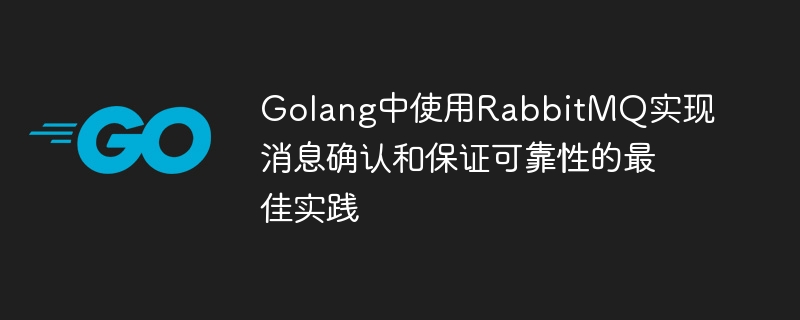

The best practice of using RabbitMQ in Golang to implement message confirmation and ensure reliability requires specific code examples
With the popularity of microservice architecture, message queues have become One of the important tools to solve communication problems between microservices. RabbitMQ, as a reliable, high-performance open source message queue middleware, is widely used in various scenarios. Using RabbitMQ in Golang to implement message confirmation and ensure reliability can ensure that the message reaches the target consumer and the consumer has successfully processed it.
Below we will introduce a best practice for using RabbitMQ in Golang to achieve message confirmation and ensure reliability. In this practice, we mainly focus on the two aspects of message sending and consumption, and use the message confirmation mechanism to ensure the reliable delivery of messages.
First, we need to introduce the Golang client library of RabbitMQ. In Golang, a more commonly used library is "streadway/amqp". It can be installed in the following way:
go get github.com/streadway/amqp
Next, we create a RabbitMQ connection and declare a message channel for sending and receiving messages. The code example is as follows:
import (
"fmt"
"log"
"github.com/streadway/amqp"
)
func main() {
// 连接RabbitMQ服务器
conn, err := amqp.Dial("amqp://guest:guest@localhost:5672/")
if err != nil {
log.Fatal(err)
}
defer conn.Close()
// 创建一个消息通道
channel, err := conn.Channel()
if err != nil {
log.Fatal(err)
}
defer channel.Close()
// ...
// 其他代码
}After successfully connecting to the RabbitMQ server and creating a message channel, we can start sending messages. Before sending a message, we need to declare a message queue to ensure that the message can be correctly received by consumers. The code example is as follows:
// 声明一个消息队列
queue, err := channel.QueueDeclare("my_queue", true, false, false, false, nil)
if err != nil {
log.Fatal(err)
}Next, we can send a message to the queue just declared through the message channel. The code example is as follows:
// 发送一条消息
err = channel.Publish("", queue.Name, false, false, amqp.Publishing{
ContentType: "text/plain",
Body: []byte("Hello, RabbitMQ!"),
})
if err != nil {
log.Fatal(err)
}After successfully sending the message, we need to set up the consumer to receive and process the message. In RabbitMQ, the "Basic Consume" is generally used to achieve message consumption. The code example is as follows:
// 消费消息
msgs, err := channel.Consume(queue.Name, "", true, false, false, false, nil)
if err != nil {
log.Fatal(err)
}
// 处理接收到的消息
go func() {
for msg := range msgs {
log.Printf("Received a message: %s", msg.Body)
// 消息处理逻辑...
// 消息确认
msg.Ack(false)
}
}()In the above code, we create a consumer to receive messages from the specified queue through the Consume method. Then, use a goroutine to process the received message. After processing is complete, we call msg.Ack(false) to confirm that the message was processed. False here means only confirming the current message, not all previous unconfirmed messages.
Through the above code examples, we can use RabbitMQ in Golang to confirm messages and ensure reliability. The sender uses the message confirmation mechanism to ensure that the message can be sent successfully, while the receiver uses the message confirmation mechanism to confirm that the message has been processed to avoid message loss or repeated consumption. This practical method is suitable for various scenarios, especially for business scenarios with high data consistency requirements, and can increase the reliability and stability of the system.
I hope the above content can help you better use RabbitMQ to achieve message confirmation and ensure reliability in actual development work. At the same time, I hope that through this article, you can have a deeper understanding of the combined use of Golang and RabbitMQ.
The above is the detailed content of Best practices for using RabbitMQ to implement message confirmation and ensure reliability in Golang. For more information, please follow other related articles on the PHP Chinese website!
 How to define variables in golang
How to define variables in golang
 What are the data conversion methods in golang?
What are the data conversion methods in golang?
 What is the difference between rabbitmq and kafka
What is the difference between rabbitmq and kafka
 What are the commonly used libraries in golang?
What are the commonly used libraries in golang?
 What is the difference between golang and python
What is the difference between golang and python
 How to withdraw money on WeChat without handling fees
How to withdraw money on WeChat without handling fees
 propertydescriptor usage
propertydescriptor usage
 What are the types of traffic?
What are the types of traffic?
 Check folder size in linux
Check folder size in linux




